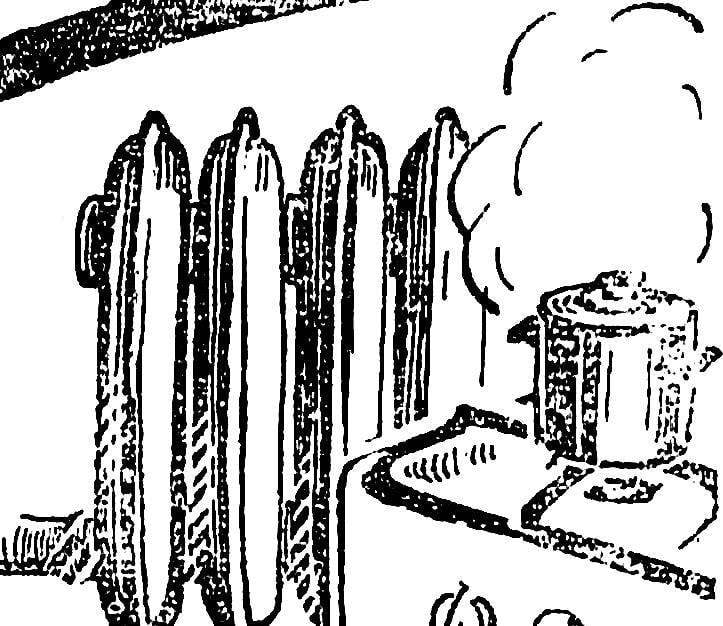The simplest mixer is easy to make in the form of the impeller drive flexible connections through the same siphon tubing (Fig. 3). There is no need in continuous rotation in one direction. If the mixer is equipped with radial blades, enough oscillation. You can limit and a single blade (Fig. 2). Even here the scope for their own decisions. As the rod is best to use rot-the materials, e.g., insulated wiring or nylon (chloride) wire, sold in hardware stores as linen.
There is also the problem of the stability of the bell. Readers, carefully studied the material “Biogas: and warms, and cooks”, has already pointed out that if the schema represented in figure 1, to carry out, without modifying the design, the bell can lose its balance as soon as emerge: either capsize or jam. Figure 3 in the same publication are not accidentally provided the guide tube to the bell, but this installation is more difficult for domestic production.
In the figure we show the schema of the trim of the bell with two blocks (Fig. 4A) and a counterweight and “crane” (Fig. 4B). The error resulting due to the lax vertical movement of the suspension point of the bell on the “crane” (on the arc of a circle), negligible in connection with a significant excess of the lever arm on the rocker arm.
Fig. 4.
This system balance the bells the best that it can be used as a lifting device during inspection and cleaning of the fermenter. Given this, it is easy to complement the design of some auxiliary elements: blocks is better positioned to re the arrow (it is only to lift the bell to work under him, absolutely not allowed — “do Not stand under the load!”). Should do swivel and arm support “crane”, as opposed to stacked, as storage scales. But if in your area the frost does not happen, it provides a counterbalance in the form of a container filled with water.
The most serious difficulty standing in the way of homebrew, the manufacture of bells. Galvanized roofing iron allows you to give it the desired shape by simple means, moreover, it will be mild. But the fragility of the material in rapid corrosion in aggressive environment makes to look for other options. Therefore, we strongly suggest to look at the available scrap. Old containers, e.g. from petroleum, being circumcised can be very suitable prefabricated, in form (usually with welded spherical bottoms), and the thickness of the sheet material from 2 to 5 mm.
Apparently, the popular sizes of bells will Ø 2-3 m and the same height. If the “barrel” turns out to be less, you should consider whether to make a big bell or take two smaller ones (for example, Ø 1.5 m), at the same time returning to the variant of coupled simple units.
Some readers raised the question about the definition of gas pressure. Apparently, they did not pay attention to the obvious: as soon as the bell comes up — the force of the gas pressure has reached the level of mass bells. Let us explain this with an example. When the diameter of the skirt of the bell is 2 m, the area of its cross-section will be S=NR2 =3,14*1=3,14 m2 =31 400 cm2 . The wall thickness of the bell is 5 mm and a height of 2 m and its weight will be about 500 kg. Suppose that the actual weight of the bell is 470 kg. Then the bell comes up at a gas pressure of 0.15 bar. (In the SI system mass M = 470 kg, the weight force G = 4700 N, the gas pressure p = 4700/31 400 = 0.15 N/cm2 = 0.15 ATM).
With the rise of the pressure bell is almost unchanged, its increase will only occur due to displacement of liquid volume equal to the supernatant of the side walls of the bell.
Noting the low gas pressure, we see that it (if necessary) can be enhanced by a simple method: install on the bell additional weight, placing it lower, for better balance of the bell.
Several interesting examples for comparison. The gas pressure in the urban network is in the range of 200-300 mm of water. article, and allowed up to 600 mm of water. art. In our system, this pressure should be the limit. Naturally, the question arises: is a private farmstead are able to give the materials sufficient? Of course not. Our recommendations relate primarily to the cooperative livestock farms, receiving every day more and more development. In addition, the reserves, and lie a lot of the farms: sometimes near livestock farms accumulated a significant amount of manure that is not used. Local residents could dispose of it, and then out to the field. After all waste materials from the fermenter is almost does not lose its value as a fertilizer. There is a double economic benefit.
In conclusion, reiterate our appeal to readers to share their experiences in the design and operation of biogas plants.
 The editors have received many letters on the publication of “Biogas: and warms, and cooks” (see “M-K” № 1, 1987), based on the materials of the Romanian journal “Technium”. Of readers was attracted by the subject and documented in the design. Many are interested in the details of the devices bostanova, asking how to make the individual nodes. Further clarification and recommendations for possible solutions to the structural elements gives our consultant engineer P. Zach.
The editors have received many letters on the publication of “Biogas: and warms, and cooks” (see “M-K” № 1, 1987), based on the materials of the Romanian journal “Technium”. Of readers was attracted by the subject and documented in the design. Many are interested in the details of the devices bostanova, asking how to make the individual nodes. Further clarification and recommendations for possible solutions to the structural elements gives our consultant engineer P. Zach.